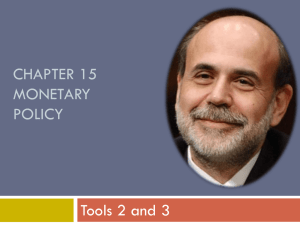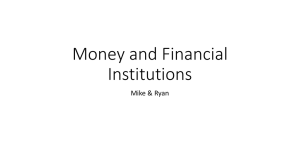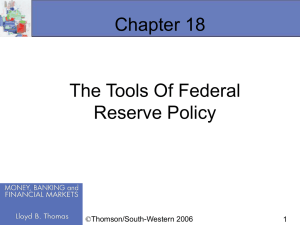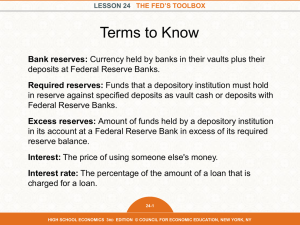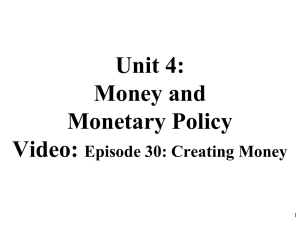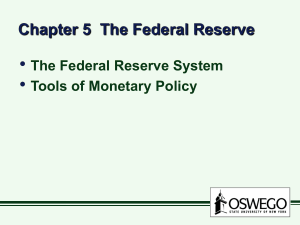25_econ_chapter_15
advertisement
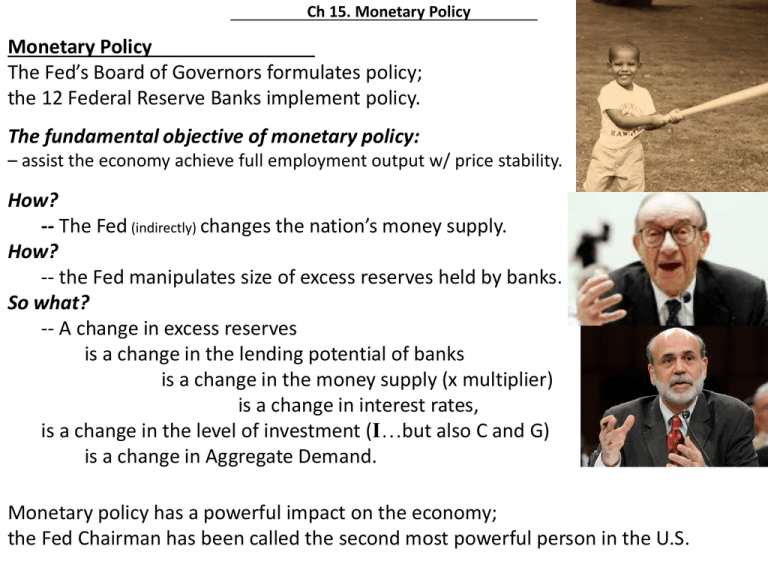
Ch 15. Monetary Policy Monetary Policy The Fed’s Board of Governors formulates policy; the 12 Federal Reserve Banks implement policy. The fundamental objective of monetary policy: – assist the economy achieve full employment output w/ price stability. How? -- The Fed (indirectly) changes the nation’s money supply. How? -- the Fed manipulates size of excess reserves held by banks. So what? -- A change in excess reserves is a change in the lending potential of banks is a change in the money supply (x multiplier) is a change in interest rates, is a change in the level of investment (I…but also C and G) is a change in Aggregate Demand. Monetary policy has a powerful impact on the economy; the Fed Chairman has been called the second most powerful person in the U.S. Consolidated Balance Sheet of the Federal Reserve Banks The assets on the Fed’s balance sheet contains two major items: • Securities (federal government bonds purchased by Fed) • Loans to commercial banks (and other “thrifts”) “receivables from” The liabilities side of the balance sheet contains three major items: • Reserves of other banks held as deposits at Federal Reserve Banks, • U.S. Treasury deposits of tax receipts and borrowed funds, and • Federal Reserve Notes outstanding, our paper currency. “payable to” The Fed’s Three Major Tools of Monetary Policy • Open-market operations: the Fed’s buying and selling of government bonds. • The reserve ratio: the manipulation of the reserve ratio to change money supply • The discount rate: interest % that the Fed charges to banks borrowing from the Fed Three Tools of Monetary Policy 1. Open-market operations -- refers to the Fed’s buying and selling of government bonds. BUYING: • Buying securities will increase bank reserves and (as a secondary effect) the money supply -- The Fed is giving lending potential to banks and other sellers of securities • New lending x multiplier = ↑MS • Conclusion: When the Fed buys securities, bank reserves will increase and the money supply can rise by a multiple of these reserves. Buying is expansionary. SELLING: When the Fed sells securities, the analysis is reversed: • Bank reserves decrease and the money supply will decrease by a multiple of the banks’ decrease in reserves. Selling is contractionary. Three Tools of Monetary Policy 2. The reserve ratio -- the fraction of reserves required relative to a bank’s customer deposits • Raising the reserve ratio increases required reserves but shrinks excess reserves. • A reduction of excess reserves reduces a bank’s lending ability which reduces money supply by a multiple of the change in excess reserves. • Raising the reserve ratio is contractionary. • Lowering the reserve ratio decreases the req’d reserves & expands excess reserves. • Increases to excess reserves increases banks’ lending ability, which increases the money supply by a multiple of the change in excess reserves. • Lowering the reserve ratio is expansionary. Changing the reserve ratio has two effects: i. it affects the size of excess reserves. ii. it changes the size of the monetary multiplier. -- e.g. if ratio is lowered 2% from 10% to 8%, the multiplier increases 25% (from 10 to 12.5) Changing the reserve ratio is very powerful; it affects banks’ lending ability immediately. It could create instability, so Fed rarely changes it. Three Tools of Monetary Policy 3. The discount rate -- the interest rate that the Fed charges to banks that borrow from the Fed. • An increase in the discount rate signals that borrowing reserves is more difficult and will tend to shrink excess reserves. -- lending limited, money supply decreases, increase in interest rates, decrease in AD Increasing the discount rate is contractionary. • A decrease in the discount rate signals that borrowing reserves will be easier and will tend to expand excess reserves -- more lending, money supply increases, decrease in interest rates, increase in AD Decreasing the discount rate is expansionary. “Easy” monetary policy: Expansionary: the Fed tries to increase money supply by expanding excess reserves in order to stimulate the economy. The Fed will use a combination of: • buying securities • reducing the reserve ratio (rare) • reducing the discount rate “Tight” monetary policy: Contractionary: Fed tries to decrease money supply by decreasing excess reserves in order to slow spending in the economy during an inflationary period. The Fed may: • sell securities • raise the reserve ratio (rare) • raise the discount rate. Three Tools of Monetary Policy Open-market operations give the Fed most control of the three “tools.” • securities can be bought or sold quickly and in great quantities. Reserves change quickly in response. The reserve ratio is rarely changed since this could destabilize bank’s lending and profit positions. Changing the discount rate has only a nominal impact. • for various reasons only 2-3 percent of bank reserves are borrowed from Fed… … the Fed is the “lender of last resort” … … but changing the discount rate is very relevant for its “announcement effect” as an indicator of the direction of monetary policy. 15-3 (Key Question) Suppose that you are a member of the Board of Governors of the Federal Reserve System. The economy is experiencing a sharp and prolonged inflationary trend. What changes in (a) the reserve ratio, (b) the discount rate, and (c) open-market operations would you recommend? Explain in each case how the change you advocate would affect commercial bank reserves, the money supply, interest rates, and aggregate demand. (a) Increase the reserve ratio. This would increase the size of required reserves; loan collections > lending The money supply would decrease, interest rates would rise, aggregate demand would decline. (b) Increase the discount rate. This would decrease commercial bank borrowing from the Fed. Actual reserves of the commercial banks would fall, as would excess reserves and lending. The money supply would drop, interest rates would rise, and AD would decline. (c) Sell government securities in the open market. Buyers of the bonds would write checks to the Fed on their demand deposits, reducing the money supply. Interest rates would rise and AD would fall. 15-4 (Key Question) What is the basic objective of monetary policy? The basic objective of monetary policy is to assist the economy in achieving a fullemployment, non-inflationary level of total output. State the cause-effect chain through which monetary policy is made effective. Changes in the money supply affect interest rates, which affect investment spending and therefore aggregate demand. What are the major strengths and weaknesses of monetary policy? Strengths: • faster and more flexible than fiscal policy. • the Board of Governors is somewhat removed from political pressure • has historically been successful in preventing inflation and keeping prices stable. Weaknesses: • traditional money supply is less significant with widespread adoption of electronic banking, credit, etc. • while monetary policy has proved helpful is stabilizing price level, it is not as effective in recession recovery efforts. 15-7 (Last Word) How do each of the following metaphors apply to the Federal Reserve’s role in the economy: Fed as a mechanic; Fed as a warrior; Fed as a fall guy? The Fed is a mechanic in the sense that it is responsible for “tightening” or “loosening” the money supply. If we view the economy as a machine and the money supply as one of its parts, the Fed takes on the task of adjusting that part in order to “fix” the economy machine. The Fed is a warrior in the sense that it is asked to “fight” inflation. Policies that reduce inflation are generally unpopular although inflation may be persistent; the term “fight” is used in the “battle” against inflation. Because the Fed is independent, its policies are often blamed for many of the economy’s ills or its failure to perform as desired. Politicians can blame their own failures to enact appropriate fiscal policies on the Fed. The Fed is thus a “fall guy” whenever the economy does not behave as desired. http://www.youtube.com/watch?v=HdZnOQp4SmU


